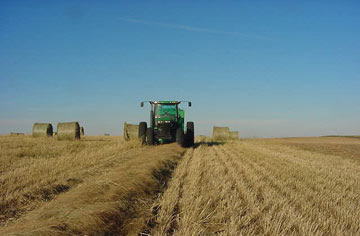|
NEWS NOTES
Switching to switchgrass
 Jerry Roitsch |
| Jerry Roitsch harvests switchgrass on his farm near Bristol, S.D. |
After decades of feeding cattle and securing topsoil in the Great Plains, switchgrass — a feathery perennial native to the region — is being groomed for a new role: green energy production. A five-year field study found that ethanol made from switchgrass yields 5.4 times the amount of fossil fuel energy it takes to grow, harvest and convert the grass to fuel.
Corn ethanol, once the belle of the green energy ball, pales in comparison: The U.S. Department of Agriculture estimates that it produces 1.3 times the amount of energy its production consumes.
Switchgrass, a form of biomass that can be broken down and fermented to form cellulosic ethanol, had its first brush with fame in 2006, when President Bush mentioned the plant as a potential energy source in his State of the Union address. But switchgrass appears to have more than just political potential.
Previous studies have found that switchgrass ethanol produces anywhere from three to seven times as much energy as its production consumes. But those numbers were based on data generated on small research plots, says Ken Vogel, a geneticist at the U.S. Department of Agriculture who published his results in the Jan. 15 issue of the Proceedings of the National Academy of Sciences. That makes it hard to measure energy inputs, he says, because “you’re not operating full-scale equipment” like large tractors. So in 2000, Vogel and his colleagues began working with 10 farmers in North Dakota, South Dakota and Nebraska to establish full-size switchgrass fields ranging from 30,000 to 90,000 square meters.
To determine energy input, Vogel and his colleagues carefully tracked the farmers’ application of herbicides and fertilizer, the quantity of switchgrass seed planted and the amount of diesel fuel burned by the equipment. To determine how much ethanol would be produced, the researchers relied on a standard conversion number: Every 0.38 kilograms of switchgrass yielded one liter of ethanol. Thus ethanol and energy output depended on the farmers’ yields. Not only was the energy balance of switchgrass ethanol favorable, but the researchers found that the fuel is nearly carbon neutral. Burning switchgrass ethanol releases about the same amount of carbon dioxide that growing switchgrass takes up.
And there’s more good news. “I believe their numbers are very conservative,” says David Bransby, a professor of energy crops at Auburn University in Alabama. Switchgrass fields in the southern United States, because of the warmer climate, could yield even more biomass, he says.
“The one kicker,” Vogel says, “is that there are no biorefineries built.” The Department of Energy, however, hopes to soon remedy that problem. In February 2007, the agency announced that it would invest $385 million to develop six commercial plants across the United States. The plants are set to come online no later than 2012. When fully operational, they’ll consume nearly 5,000 tons of biomass each day.
That’s good news for Jerry Roitsch, who planted a test field for Vogel near Bristol, S.D. He plans to keep harvesting switchgrass. “It’s so prolific and so dense,” Roitsch says. “I want to see how long it will go.”
But Bransby isn’t convinced that converting the cellulose found in switchgrass and other plants into ethanol is the best way forward. Although ethanol produced from switchgrass is better than corn ethanol, both contain just two-thirds of the energy found in gasoline, he says. “The reason that a lot of people are saying that cellulosic ethanol is the way to go is because they don’t realize other options exist,” Bransby says. “There are companies out there that can produce gasoline and diesel from biomass.”
Links:
"Bush addreses alternative energy," Geotimes online, Web Extra, Feb. 3, 2006
"Peak Ethanol," Geotimes, December 2007

 Subscribe
Subscribe


